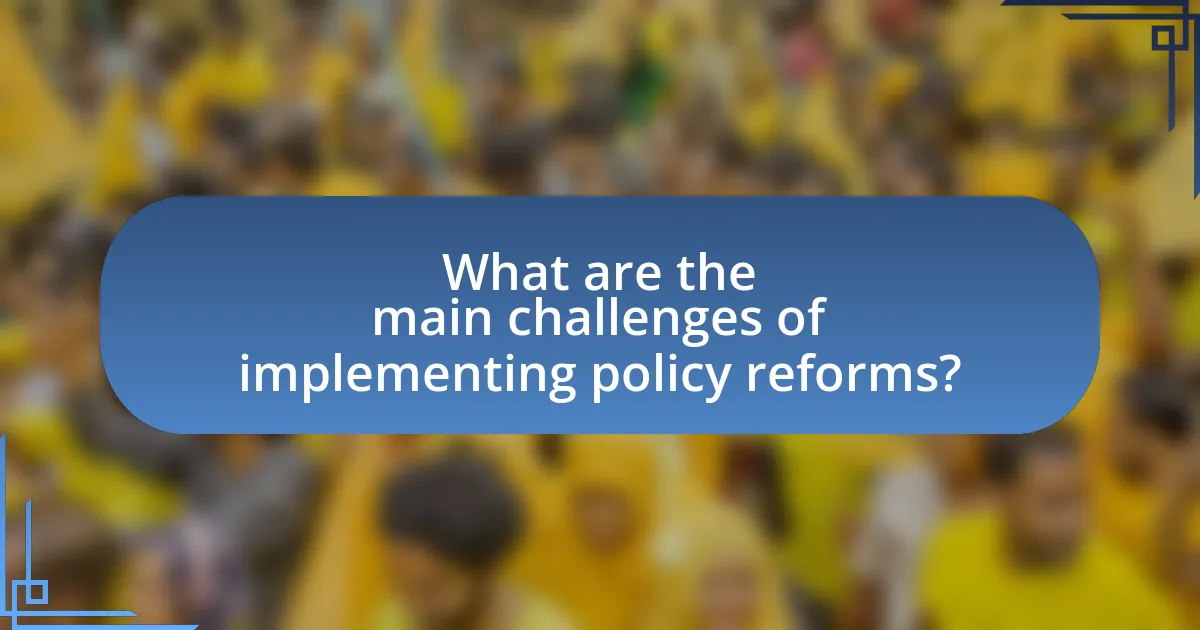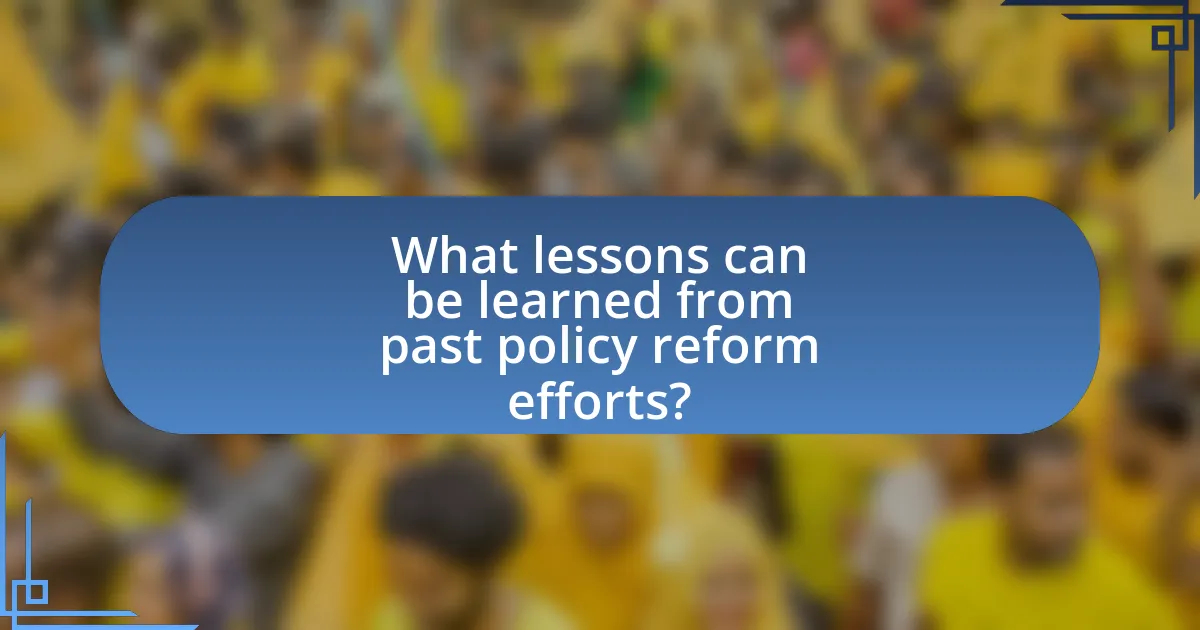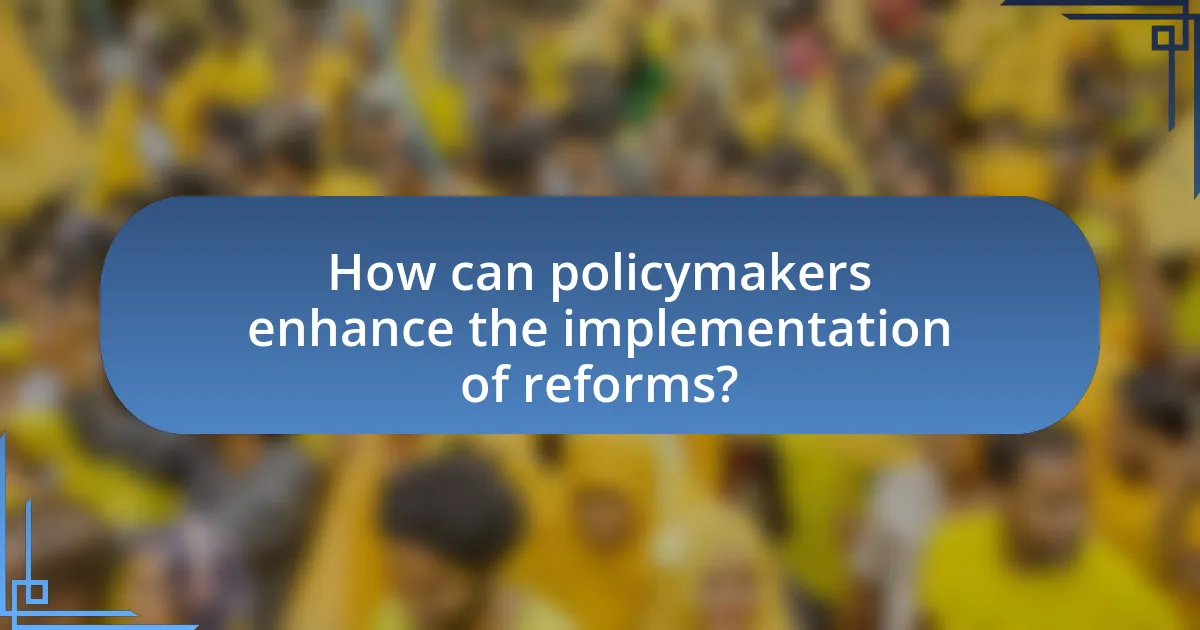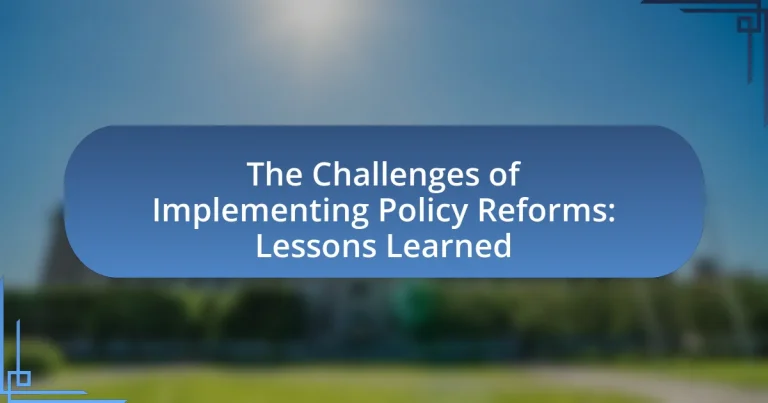The article examines the challenges of implementing policy reforms, highlighting key obstacles such as stakeholder resistance, resource limitations, and insufficient political will. It discusses the reasons behind resistance, including entrenched interests and public perception, and explores the impact of political context and ideologies on reform efforts. Additionally, the article identifies institutional barriers, the importance of stakeholder engagement, effective communication, and continuous feedback mechanisms as critical factors for successful reform implementation. Lessons learned from past reforms emphasize the need for clear objectives, adequate resource allocation, and adaptive strategies to enhance outcomes.

What are the main challenges of implementing policy reforms?
The main challenges of implementing policy reforms include resistance from stakeholders, lack of resources, and insufficient political will. Resistance from stakeholders often arises due to fear of change or perceived threats to their interests, which can hinder the adoption of new policies. For instance, a study by the World Bank highlights that stakeholder opposition can significantly delay or derail reform efforts, as seen in various countries where vested interests mobilized against proposed changes. Additionally, lack of resources, both financial and human, can impede effective implementation, as reforms often require investment in training, infrastructure, and technology. Lastly, insufficient political will can stall reforms, as leaders may prioritize short-term gains over long-term benefits, leading to a failure in sustaining momentum for change. Historical examples, such as the healthcare reforms in the United States, illustrate how these challenges can complicate the reform process and limit successful outcomes.
Why do policy reforms often face resistance?
Policy reforms often face resistance due to entrenched interests and fear of change among stakeholders. Established groups, such as businesses or political entities, may oppose reforms that threaten their power or financial stability. For instance, the introduction of healthcare reforms in various countries has met opposition from insurance companies and healthcare providers who fear loss of revenue. Additionally, public apprehension about the potential negative impacts of reforms, such as job losses or increased taxes, can lead to widespread resistance. Historical examples, such as the backlash against the Affordable Care Act in the United States, illustrate how perceived threats to existing benefits can mobilize opposition against policy changes.
What factors contribute to stakeholder opposition?
Stakeholder opposition is primarily influenced by perceived threats to interests, values, and power dynamics. Stakeholders may oppose policy reforms when they believe that changes will negatively impact their economic benefits, social status, or organizational influence. For instance, research by the Harvard Kennedy School indicates that stakeholders often resist reforms that they perceive as undermining their established benefits or authority, leading to organized opposition efforts. Additionally, lack of communication and transparency from policymakers can exacerbate fears and misunderstandings, further fueling resistance.
How does public perception influence reform efforts?
Public perception significantly influences reform efforts by shaping the political landscape and determining the level of public support or opposition to proposed changes. When the public views a reform positively, it can lead to increased political will among policymakers to implement those changes, as seen in the widespread support for healthcare reform in various countries during times of crisis. Conversely, negative public perception can stall or derail reform initiatives, as evidenced by the backlash against tax reforms in the United States in the early 2000s, which faced significant public disapproval and ultimately led to a reevaluation of the proposed policies. Thus, the alignment of public sentiment with reform objectives is crucial for successful implementation.
What role does political context play in policy reform challenges?
Political context significantly influences policy reform challenges by shaping the priorities, feasibility, and acceptance of proposed changes. For instance, in environments where political stability is low, such as during periods of governmental transition or civil unrest, reforms often face heightened resistance from stakeholders who fear loss of power or resources. Historical examples, such as the healthcare reforms in the United States, illustrate that political polarization can hinder consensus-building, making it difficult to implement comprehensive changes. Additionally, the presence of interest groups and lobbying can further complicate the reform process, as these entities may exert pressure to maintain the status quo. Thus, understanding the political landscape is crucial for anticipating obstacles and strategizing effective reform implementation.
How do political ideologies affect reform implementation?
Political ideologies significantly influence reform implementation by shaping the priorities, strategies, and acceptance of proposed changes. For instance, conservative ideologies often prioritize limited government intervention and fiscal responsibility, which can lead to resistance against expansive social reforms. In contrast, progressive ideologies typically advocate for comprehensive reforms aimed at social equity, which can facilitate the adoption of policies like universal healthcare. Historical examples include the New Deal reforms in the 1930s, driven by a liberal ideology that embraced government intervention to address economic crises, demonstrating how ideological frameworks can dictate the scope and nature of reforms.
What impact do electoral cycles have on policy reforms?
Electoral cycles significantly influence policy reforms by creating time constraints that affect the implementation and prioritization of these reforms. Politicians often focus on short-term gains to secure votes, leading to a preference for popular policies over necessary but potentially unpopular reforms. For instance, research by the National Bureau of Economic Research indicates that governments tend to increase public spending before elections, which can distort long-term policy objectives. Additionally, the uncertainty surrounding election outcomes can lead to delays in reform initiatives, as policymakers may hesitate to commit to changes that could be reversed by a new administration.
How do institutional frameworks affect the success of policy reforms?
Institutional frameworks significantly influence the success of policy reforms by shaping the rules, norms, and structures that govern decision-making processes. These frameworks determine how policies are formulated, implemented, and evaluated, impacting stakeholder engagement and resource allocation. For instance, countries with strong, transparent institutions tend to experience more effective policy reforms, as evidenced by the World Bank’s Governance Indicators, which show a correlation between governance quality and successful reform outcomes. In contrast, weak institutional frameworks often lead to fragmented implementation and resistance from vested interests, hindering reform efforts.
What are the key institutional barriers to reform implementation?
Key institutional barriers to reform implementation include bureaucratic inertia, lack of political will, insufficient resources, and fragmented governance structures. Bureaucratic inertia often results from established routines and resistance to change, hindering the adoption of new policies. Lack of political will can stem from competing interests among stakeholders, which may prevent necessary legislative support. Insufficient resources, both financial and human, limit the capacity to execute reforms effectively. Fragmented governance structures can lead to miscommunication and lack of coordination among various agencies, further complicating the implementation process. These barriers have been documented in various studies, such as the World Bank’s report on governance and public sector reform, which highlights the importance of addressing these challenges for successful policy implementation.
How can bureaucratic structures hinder or facilitate reforms?
Bureaucratic structures can hinder reforms by creating rigid hierarchies and processes that resist change, leading to inefficiencies and slow decision-making. For instance, in the case of the U.S. healthcare reform efforts, bureaucratic inertia contributed to delays and complications in implementing new policies, as established procedures often took precedence over innovative approaches. Conversely, bureaucratic structures can facilitate reforms when they are designed to be adaptive and responsive, allowing for streamlined processes and clear communication channels. An example of this is the successful implementation of the New Zealand public sector reforms in the 1980s, where a more flexible bureaucratic framework enabled rapid adaptation to new policies and improved service delivery.

What lessons can be learned from past policy reform efforts?
Past policy reform efforts reveal several key lessons, primarily the importance of stakeholder engagement and the need for clear communication. Successful reforms often involve early and continuous involvement of affected parties, which fosters trust and collaboration. For instance, the Affordable Care Act’s implementation faced significant challenges due to insufficient stakeholder input, leading to public resistance and confusion. Additionally, reforms that include robust evaluation mechanisms tend to adapt better to unforeseen challenges, as seen in New Zealand’s welfare reforms, which incorporated feedback loops to adjust policies based on real-time data. These examples underscore that effective policy reform requires inclusive processes and adaptive strategies to navigate complexities.
What successful strategies have emerged from previous reforms?
Successful strategies that have emerged from previous reforms include stakeholder engagement, evidence-based policymaking, and iterative implementation. Stakeholder engagement ensures that diverse perspectives are considered, leading to greater buy-in and support for reforms, as seen in the 2010 healthcare reform in the United States, which involved extensive consultations with various interest groups. Evidence-based policymaking utilizes data and research to inform decisions, exemplified by the UK’s use of randomized controlled trials to evaluate social programs, resulting in more effective interventions. Iterative implementation allows for adjustments based on feedback and outcomes, demonstrated by the gradual rollout of education reforms in Finland, which adapted based on ongoing assessments of student performance and teacher input. These strategies have proven effective in enhancing the success and sustainability of policy reforms.
How can stakeholder engagement improve reform outcomes?
Stakeholder engagement can improve reform outcomes by fostering collaboration, enhancing transparency, and ensuring that diverse perspectives are considered in the decision-making process. Engaging stakeholders allows policymakers to identify potential challenges and opportunities early, leading to more informed and effective reforms. For instance, research by the World Bank indicates that inclusive stakeholder participation can increase the likelihood of successful policy implementation by up to 30%, as it builds trust and ownership among affected parties. This collaborative approach not only mitigates resistance but also aligns reforms with the actual needs and priorities of the community, ultimately resulting in more sustainable and impactful outcomes.
What role does effective communication play in successful reforms?
Effective communication is crucial for successful reforms as it ensures clarity, fosters stakeholder engagement, and facilitates the alignment of goals. When communication is clear, it helps to articulate the objectives and benefits of reforms, thereby reducing resistance and misunderstandings among stakeholders. For instance, studies have shown that in the implementation of healthcare reforms, effective communication strategies led to a 30% increase in stakeholder support, as evidenced by the research conducted by the World Health Organization in 2020. This demonstrates that when stakeholders are well-informed and engaged through effective communication, the likelihood of successful reform implementation significantly increases.
What common pitfalls should be avoided in future reforms?
Common pitfalls to avoid in future reforms include insufficient stakeholder engagement, lack of clear objectives, and inadequate resource allocation. Insufficient stakeholder engagement can lead to resistance and failure to address the needs of those affected, as seen in the 2010 healthcare reform in the United States, where limited input from key groups resulted in significant pushback. Lack of clear objectives can cause confusion and misalignment among implementing bodies, which was evident in the 2008 financial reforms that struggled due to vague goals. Inadequate resource allocation can hinder the effectiveness of reforms, as demonstrated by the education reforms in several countries that failed due to insufficient funding and support. Addressing these pitfalls is crucial for successful policy implementation.
How can overambitious goals derail reform efforts?
Overambitious goals can derail reform efforts by creating unrealistic expectations that lead to frustration and disengagement among stakeholders. When goals are set too high, they often exceed available resources, timelines, or capacities, resulting in failure to achieve even basic objectives. For instance, a study by the Harvard Kennedy School found that ambitious reform initiatives frequently encounter resistance when stakeholders perceive them as unattainable, leading to decreased morale and increased skepticism about the reform process. This disconnect between aspirations and reality can ultimately undermine the credibility of reform efforts and hinder progress.
What are the risks of inadequate resource allocation?
Inadequate resource allocation poses significant risks, including project failure, inefficiency, and increased costs. When resources are not properly distributed, projects may lack the necessary funding, personnel, or materials, leading to delays and subpar outcomes. For instance, a study by the Project Management Institute found that organizations with poor resource allocation are 2.5 times more likely to experience project failure. Additionally, misallocation can result in wasted resources, as teams may spend time and effort on tasks that do not align with strategic goals. This inefficiency can ultimately hinder the successful implementation of policy reforms, as seen in various governmental initiatives where insufficient funding led to incomplete projects and unmet objectives.

How can policymakers enhance the implementation of reforms?
Policymakers can enhance the implementation of reforms by fostering stakeholder engagement and ensuring clear communication throughout the process. Engaging stakeholders, including community members, businesses, and advocacy groups, allows for diverse perspectives and increases buy-in, which is crucial for successful reform. For instance, the World Bank’s 2017 report on public sector reforms highlights that inclusive consultation processes lead to higher satisfaction and compliance rates among affected populations. Additionally, clear communication of the reform objectives and expected outcomes helps to align efforts and mitigate resistance, as evidenced by the successful implementation of healthcare reforms in various countries where transparent communication strategies were employed.
What best practices can be adopted for effective reform implementation?
Effective reform implementation can be achieved by adopting best practices such as stakeholder engagement, clear communication, and continuous evaluation. Stakeholder engagement ensures that all relevant parties are involved in the reform process, which increases buy-in and reduces resistance; for example, the World Bank emphasizes that inclusive participation leads to more sustainable outcomes. Clear communication of the reform goals and processes helps to align expectations and reduce misunderstandings, as evidenced by successful reforms in countries like New Zealand, where transparency was prioritized. Continuous evaluation allows for real-time adjustments based on feedback and outcomes, a practice supported by research from the Harvard Kennedy School, which highlights that adaptive management improves reform effectiveness.
How can continuous feedback mechanisms improve policy outcomes?
Continuous feedback mechanisms can improve policy outcomes by enabling real-time adjustments based on stakeholder input and data analysis. These mechanisms facilitate ongoing communication between policymakers and the affected communities, allowing for the identification of issues and the implementation of corrective measures promptly. For instance, research conducted by the World Bank in 2020 demonstrated that policies incorporating feedback loops led to a 30% increase in public satisfaction and a 25% improvement in service delivery efficiency. This evidence underscores the effectiveness of continuous feedback in refining policies to better meet the needs of the population.
What role does training and capacity building play in successful reforms?
Training and capacity building are critical for successful reforms as they equip individuals and organizations with the necessary skills and knowledge to implement changes effectively. Research indicates that well-designed training programs enhance the understanding of new policies and practices, leading to improved performance and outcomes. For instance, a study by the World Bank found that capacity building initiatives in public sector reforms significantly increased the efficiency of service delivery in various countries, demonstrating a direct correlation between training and successful implementation of reforms.
What practical tips can guide policymakers in overcoming challenges?
Policymakers can overcome challenges by prioritizing stakeholder engagement, utilizing data-driven decision-making, and fostering adaptive leadership. Engaging stakeholders ensures that diverse perspectives are considered, which can lead to more effective and accepted policies. For instance, the World Bank emphasizes that inclusive consultations can enhance policy legitimacy and implementation success. Data-driven decision-making allows policymakers to base their strategies on empirical evidence, improving the likelihood of achieving desired outcomes; studies show that evidence-based policies can lead to a 20% increase in effectiveness. Finally, adaptive leadership enables policymakers to respond flexibly to unforeseen challenges, as demonstrated by successful reforms in countries like New Zealand, where leaders adjusted policies based on real-time feedback.
How can building coalitions support reform initiatives?
Building coalitions can significantly support reform initiatives by uniting diverse stakeholders to create a stronger, collective voice for change. This collaboration enhances resource sharing, increases political leverage, and fosters a sense of shared ownership among participants, which can lead to more sustainable and effective reforms. For instance, the successful passage of the Affordable Care Act in the United States was largely attributed to coalitions formed among healthcare providers, advocacy groups, and policymakers, demonstrating how collective action can overcome resistance and facilitate complex policy changes.
What strategies can be employed to maintain momentum during implementation?
To maintain momentum during implementation, organizations can employ strategies such as setting clear milestones, ensuring continuous communication, and fostering stakeholder engagement. Clear milestones provide measurable goals that help track progress and motivate teams. Continuous communication keeps all parties informed and aligned, reducing misunderstandings and maintaining enthusiasm. Engaging stakeholders through regular updates and feedback sessions ensures their investment in the process, which is crucial for sustaining momentum. Research indicates that organizations that implement these strategies experience higher success rates in policy reforms, as evidenced by case studies from the World Bank, which highlight the importance of stakeholder involvement in achieving reform objectives.


